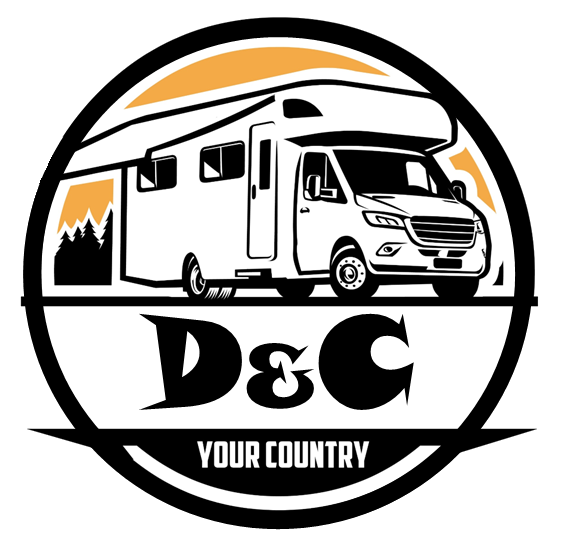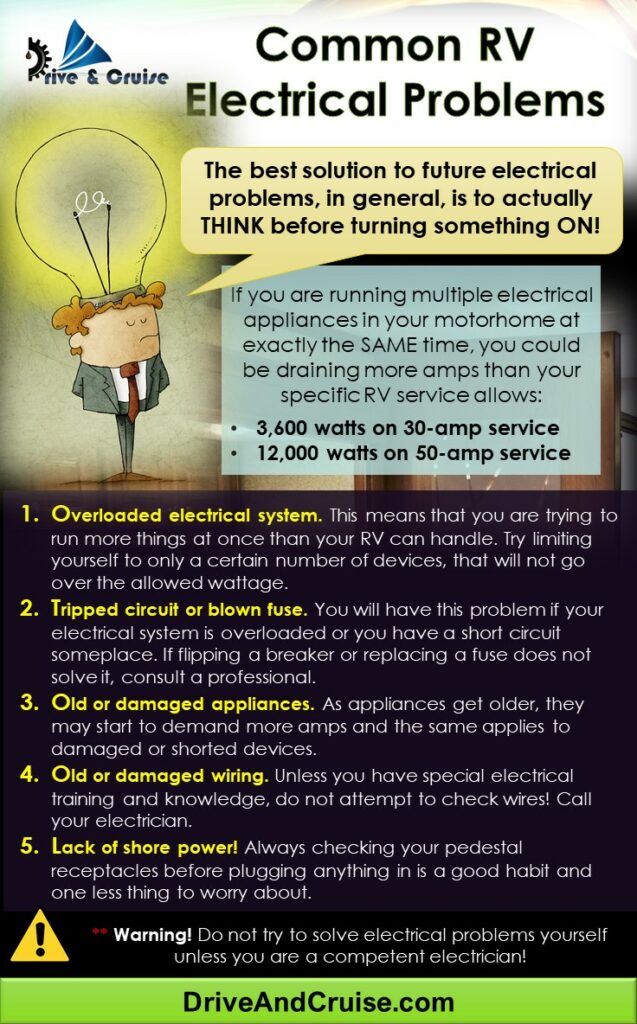![]()
Common RV Electrical Problems
DISCLAIMER: AS AN AMAZON ASSOCIATE I EARN FROM QUALIFYING PURCHASES. THIS POST CONTAINS AFFILIATE LINKS THAT WILL REWARD ME MONETARILY OR OTHERWISE WHEN YOU USE THEM TO MAKE QUALIFYING PURCHASES. FOR MORE INFORMATION, PLEASE READ MY EARNINGS DISCLAIMER.
|
- 12-volt chassis system
- 12-volt DC system (battery)
- 120-volt AC system
Before we go over these three systems, let me remind you that the number one reason for the electrical problems in RV is:
Power system overload!
If you overloaded your electrical system and the breaker flipped, all you have to do is disconnect the devices that caused it and reset the breaker. If you find a blown fuse, replace it with the one with exactly the same AMP ratings.
Some minor electrical problems could be easily solved by flipping a breaker, replacing a fuse, or resetting the GFCI outlet. Major electrical problems happen when your 120-volt outlets stop working or the refrigerator starts making weird noises, and these are the ones you don’t want to deal personally with unless you are a certified or trained electrician.
Here is a good video on how to troubleshoot RV circuit breakers and fuses:
Overload problem
When you pull into an RV park, your power choices generally look like this:
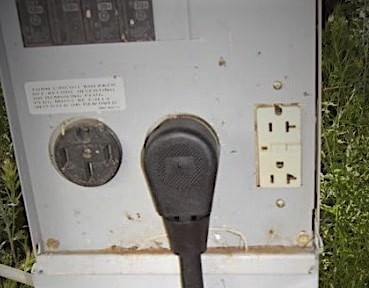
Your RV wiring is usually either:
- 30 Amp Service. Typically smaller motorhomes with 1 roof A/C.
- 50 Amp Service. Larger RVs with 2 roof air conditioners.
But before we go into details about these services, it is a good idea to clarify what are Volts, Amps, and Watts. All these ratings are so confusing to people that just want to use their electronic gadgets without knowing how they actually work.
You don’t need to know how your TV works, but you need to know how much in CONSUMES, in order to keep on watching it without interruptions. If you don’t know the basic current usage of your devices and have a limited amount of power to use, your family members will keep on flipping breakers and interrupting your movie!
By calculating our AMPs, we can make sure that we are NOT using a multitude of power-hungry devices at the same time that will get our electric system “over the edge”.
A large amount of these kinds of devices, sometimes cannot be handled by the electrical system that our RV was wired for and this is where our problems will begin.
If you look at some of the electrical products that you are using right now, they usually have a label on them with information about volts, amps, and watts. This is what your device needs to intake in order to be useful, but very often, only some of this information is mentioned and the rest you need to calculate yourself.
In order to figure out if you should limit or not limit your electrical device usage, you will need to know the following:
- What are Volts? This is kind of a “pressure” of your electrical current and when it is coming from the utilities in the United States, it is rated at 115-120 volts. Coming from the batteries – it is 12 volts.
- What are Amps? This is a flow of electricity. If too many Amps go to your electrical equipment without a circuit breaker or fuse protection, it will burn out. This is why breakers and fuses are rated in AMPs.
- What are Watts? This is the total power you get and what most electronic equipment is rated in. It is simply Amps multiplied by Volts. As an example, if you multiply 120 volts by 40 amps, you will get 4,800 watts.
It is very important to know these three things when you are trying to figure out how many AMPs your RV can handle while using the 12-volt or 120-volt system. To make matters worse, most of our electronic gadgets are rated in Watts!
Whether we like it or not, we all have to get a little nerdy when it comes to RV’s electrical power, so here are the formulas:
Watts / Volts = Amps
Amps x Volts = Watts
Watts / Amps = Volts
30-Amp Service
This is service will let you use a total of 30 amps worth of electronic or electrical equipment, which equal to:
3,600 watts
There is a special 30-amp plug that comes with this service:
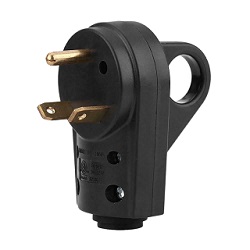
And it should be plugged into a 30-amp receptacle (or outlet) that looks like this:
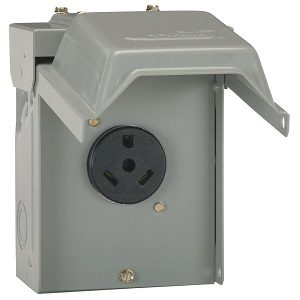
This service will give you continuous power, unlike a battery, but it is limited to 3,600 watts. If you attempt to plug your 30-amp service into a 50-amp service receptacle, your power limit will NOT increase.
Your power adapter will only decrease the amount of power going through and you will still get a 30-amp (or 3,600 watts) electrical service. This is why you need to calculate carefully how much power your devices will be using and consider this information before deciding to turn them ON.
The following 2 devices, for example, will total 3,200 watts (I will not include the actual converter usage, which is the device that requires power as well):
- A small microwave oven typically uses 1,200 watts
- Air Conditioner typically uses 2,000 watts
That means if you decide to use your hairdryer (that typically uses 1,500 watts) while you are running A/C and somebody is using a microwave, you will have a tripped breaker.
** Very important! Circuit breakers will trip at 80% of their load capacity.
50 Amp Service
With 50-amp service wiring, you can use A LOT more devices than in 30-amp service! This service gives not just 50-amps for you to use, but DOUBLE 50-amps.
With this service, you have 100-amps worth of available power, and if you multiply it by 120 volts, you get to use:
12,000 watts
This is what a 50-amp plug looks like:
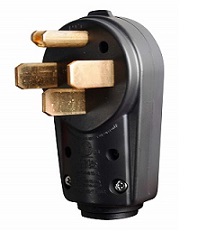
This is the receptacle for 50-amp service:
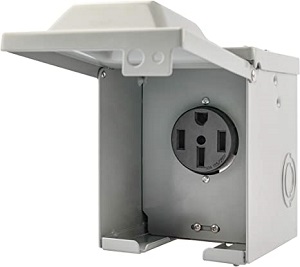
In case you ever get stuck without having access to a 50-amp shore power supply and use your adapter to plug in a 30-amp receptacle, you will get ONLY 30-amps worth of power and have to start watching your appliance usage.
With this service, you can run a lot more devices at the same time and be less concerned about power usage. This is why very often we will find full-size appliances on larger RVs with a 50-amp system.
Other electrical issues
It is not always easy to figure out what is wrong with an electrical system and sometimes it gets overwhelming. Here is a basic list of what to look for before doing any further investigation:
- Overloaded electrical system. This means that you are trying to run more things at once than your RV can handle. Try limiting yourself to only a certain number of devices, that will not go over the allowed wattage.
- Tripped circuit or blown fuse. You will have this problem if your electrical system is overloaded or you have a short circuit someplace. If flipping a breaker or replacing a fuse does not solve it, consult a professional.
- Old or damaged appliances. As appliances get older, they may start to demand more amps and the same applies to damaged or shorted devices.
- Old or damaged wiring. Unless you have special electrical training and knowledge, do not attempt to check wires! Leave it to the pros and just call your electrician.
- Lack of shore power! Always checking your pedestal receptacles before plugging anything in is a good habit and one less thing to worry about.
The electrical system of the RV is divided basically into three sections. There is a chassis electrical system, a 12-volt system to power your DC devices (lights, maybe a small refrigerator, battery charging), and a 120-volt electrical system which is the same as we use in our homes.
Let’s check them out!
Chassis electrical system (12-volts)
This system is taking power from your tow vehicle battery through a special 7-pin plug (or without a plug if you are not towing your motorhome) in order to power your exterior lights, turn signals and stop lights.
There is more information about this system in your owner’s manual. It uses its own set of fuses as well.
12-volt DC electrical system
This system usually includes a deep cycle battery and provides Direct Current (DC power) to your 12-volt interior lights, some 12-volt appliances, water pump, slide-outs, leveling jacks, and propane detector. This battery system is being charged while you are plugged into the main shore power by an electrical device called a “converter” (which also distributes power to your 12- volt appliances by converting 120-volt shore power into the proper current while you are not using a battery).
“Converter” is NOT “an inverter”. Even though the “conversion” process is taking place in both devices, the inverter is the one that you will need to connect to your 12-volt battery to run 120-volt appliances on it.
If any of your DC devices are not working, you can perform a simple check-up of your 12 volts system:
- Breakers and fuses. Open your circuit breaker panel (and this is where you will find fuses as well in most RV models) and check for a flipped breaker or a blown fuse.
- Bad or old wiring. Perform a visual check for any kind of loose wiring that is coming into the circuit board.
- Battery connections. If connections of your battery are corroded, you may not get the full power out of it. This also goes if they are not as tight as they should be.
- Battery water level. Make sure that the batteries have an adequate amount of water in them. Water is susceptible to evaporation when the batteries are overheated or overworked. Always use distilled water in your batteries, and never tap water.
- Battery charge level. Check with the multimeter if your batteries are properly charged. The voltage at the battery terminals should be around 13-14 volts DC (Direct Current) and anything below that means that it will not be able to power your appliance. If your battery is simply exhausted, you will need to recharge it as soon as you find some shore power to use. If you thought your battery was charged, but it ended up “letting you down”, you will need to troubleshoot your battery or the converter that is supposed to charge it.
- Converter problems. It is possible that the converter did not charge your battery properly and now you are having problems. Check if the converter’s breaker is flipped or if the fuses on the back of the converter are blown.
120-volt House electrical system
This system is being used, usually, while being plugged into your shore power for larger appliances like air conditioning, refrigerator, water heater, microwave, etc. This is also what supplies your outlets with power.
If you would like to use this system while on the road, you will need to use an inverter in order to change 12-volt DC power into 120-volt AC power for your appliances to be “happy with”.
The 120-volt electrical system is protected by breakers that are located inside your breaker panel. Before you start rushing and changing things inside your breaker panel, for safety sake:
Do NOT open the breaker panel and start “playing” with cables!
Electricity can be lethal if you do not know what you are doing! The ONLY thing you should look for in a breaker panel is a flipped breaker and reset it if necessary.
This is the correct way to reset your breaker:
- Flip your breaker to the OFF position.
- Flip your breaker to the ON position.
If your breaker is NOT allowing you to reset it (meaning it flips right back when you try to do so), there is a possibility of a short circuit in your device or your wiring.
Just so you know:
A blown fuse or tripped circuit breaker is actually a good thing!
This means that your fuse or breaker actually did its job, and that is to protect your investment, electronics, and the most valuable to you – your life. Now, you only have to figure out if your breaker flipped because of the electrical system overload or something more serious than that.
If you have very limited electrical knowledge, get a specialist to check your wiring and devices. Always make sure that your breakers are in good condition are NOT oversized for their load.
** Important note about your battery! Make sure that your house battery is always in good working condition, and keep it connected even if you are plugged into the shore power! Why?
Because if you turn ON too many devices or accessories, it will take on the load that your converter cannot handle. It is your converter’s job to give your DC-consuming devices the correct power level, but if it cannot keep up with your demands, it will “ask your house batteries for assistance”.
** Also Important! Before blaming something on RV’s electrical system, make sure you have an external power supply coming through. The campground source of power (or lack of it) could be a reason behind RV’s electrical problems.
So the first thing to do, as mentioned in a video below, is to check if the power is actually coming into your distribution center:
If everything is fine with your campground power supply and your fuses, but your appliances still not working properly, ask a technician to check them out.
Feel free to save the infoPin below for your future Reference :The best solution to future electrical problems, in general, is to actually THINK before turning something ON. Thinking before doing something, is actually a great practice in life as well…

You can also search our database:
Attention! This article is for informational purposes ONLY and is NOT a replacement for professional advice! ALWAYS consult your local specialist for an appropriate solution to your problem. All statements, prices, contact information, recommendations, and reviews contained herein came from sources that we believe to be reliable, but the accuracy or completeness thereof is not guaranteed. Please contact the service provider for complete details and updates.

